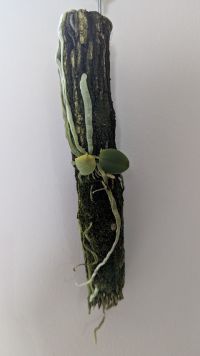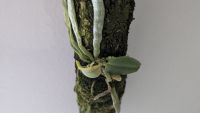(Created page with "200px|thumb|bottom|Full plant (2024-08-13) 200px|thumb|bottom|Two spikes (2024-08-13)") |
No edit summary |
||
| Line 1: | Line 1: | ||
[[File:Photo_2024-08-13_16.54.34.jpeg|200px|thumb|bottom|Full plant (2024-08-13)]] | [[File:Photo_2024-08-13_16.54.34.jpeg|200px|thumb|bottom|Full plant (2024-08-13)]] | ||
[[File:Photo_2024-08-13_16.54.36.jpeg|200px|thumb|bottom|Two spikes (2024-08-13)]] | [[File:Photo_2024-08-13_16.54.36.jpeg|200px|thumb|bottom|Two spikes (2024-08-13)]] | ||
<b>Received:</b> 2024-07-10 | |||
<b>Light:</b> 12000 - 19000 lux; 1200 - 1800 foot candles | |||
<b>Temperature:</b> Summer days average 30 - 31℃, and nights average | |||
21 - 23℃, with a diurnal range of 7 - 9℃. The plants are | |||
unusually tolerant of temperature extremes | |||
<b>Humidity:</b> 75 - 85% during the summer | |||
<b>Watering:</b> Plants should be kept moist during the growing season. The rainfall pattern is wet/dry | |||
<b>Fertilisation:</b> 1/4 - 1/2 strength, applied weekly during the growing season. | |||
Healthiest if given frequent feedings during the short growing season | |||
<b>Rest period:</b> Days average 22 - 28℃, and nights average 8 - 14℃, with a winter diurnal range of 12 - 14℃. Night temperatures frequently approach 4℃ during the dry winter, when humidity falls below 60%. A 2 - 4 month cool, drier rest with increased light is necessary for blooming and plant survival. Water should be | |||
reduced to occasional misting, but humidity should be sufficiently high to | |||
prevent dehydration of the leaves. Fertiliser should be eliminated during | |||
the dry period. As temperatures cool, the plants require less moisture. | |||
In the habitat, the period of low rainfall is extremely long, but except | |||
for 2 months, the humidity levels indicate frequent fog and morning dew. | |||
In addition, the decaying material around the roots in the plant's natural | |||
habitat helps collect and hold additional moisture during the dry season | |||
and increased nutrient levels during the growth period. | |||
<b>Blooming:</b> Inflorescences are 10cm long, usually slender and suberect. Healthy plants may produce more than a single spike. 4 - 5 flowers per inflorescence. The blooms develop sequentially. Each flower lasts about a month if kept cool, so several are open at a time. The flowers are 2.5cm or less across, fleshy, creamy white, and star-shaped. The semicircular lip is white, marked with 2 wide, vertical brown bands | |||
Latest revision as of 10:40, 14 August 2024


Received: 2024-07-10
Light: 12000 - 19000 lux; 1200 - 1800 foot candles
Temperature: Summer days average 30 - 31℃, and nights average 21 - 23℃, with a diurnal range of 7 - 9℃. The plants are unusually tolerant of temperature extremes
Humidity: 75 - 85% during the summer
Watering: Plants should be kept moist during the growing season. The rainfall pattern is wet/dry
Fertilisation: 1/4 - 1/2 strength, applied weekly during the growing season. Healthiest if given frequent feedings during the short growing season
Rest period: Days average 22 - 28℃, and nights average 8 - 14℃, with a winter diurnal range of 12 - 14℃. Night temperatures frequently approach 4℃ during the dry winter, when humidity falls below 60%. A 2 - 4 month cool, drier rest with increased light is necessary for blooming and plant survival. Water should be reduced to occasional misting, but humidity should be sufficiently high to prevent dehydration of the leaves. Fertiliser should be eliminated during the dry period. As temperatures cool, the plants require less moisture.
In the habitat, the period of low rainfall is extremely long, but except for 2 months, the humidity levels indicate frequent fog and morning dew. In addition, the decaying material around the roots in the plant's natural habitat helps collect and hold additional moisture during the dry season and increased nutrient levels during the growth period.
Blooming: Inflorescences are 10cm long, usually slender and suberect. Healthy plants may produce more than a single spike. 4 - 5 flowers per inflorescence. The blooms develop sequentially. Each flower lasts about a month if kept cool, so several are open at a time. The flowers are 2.5cm or less across, fleshy, creamy white, and star-shaped. The semicircular lip is white, marked with 2 wide, vertical brown bands